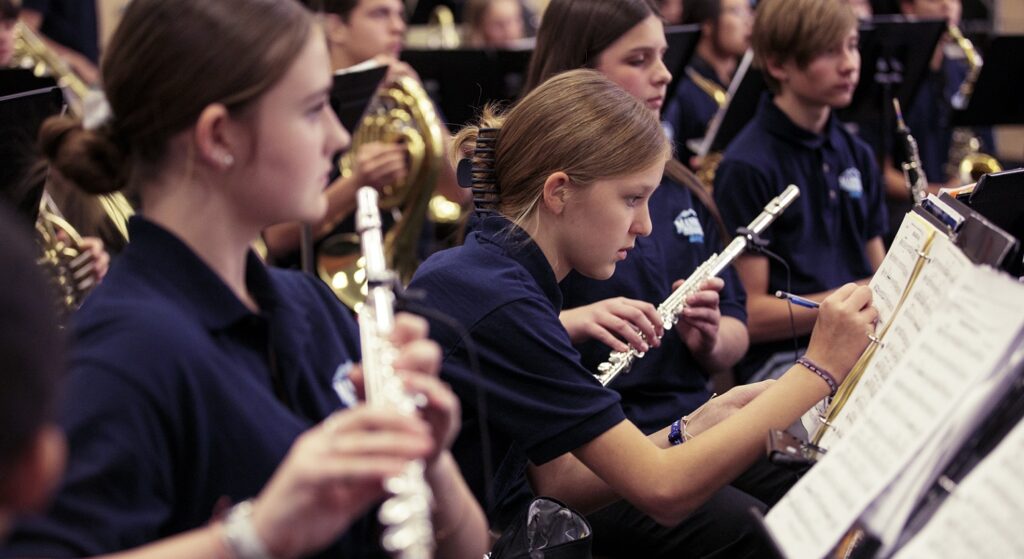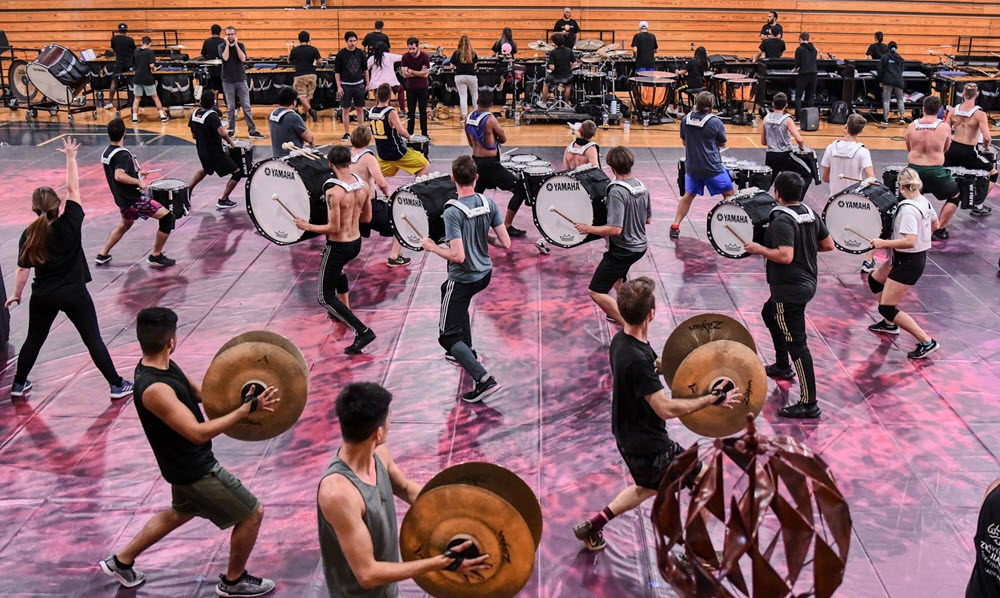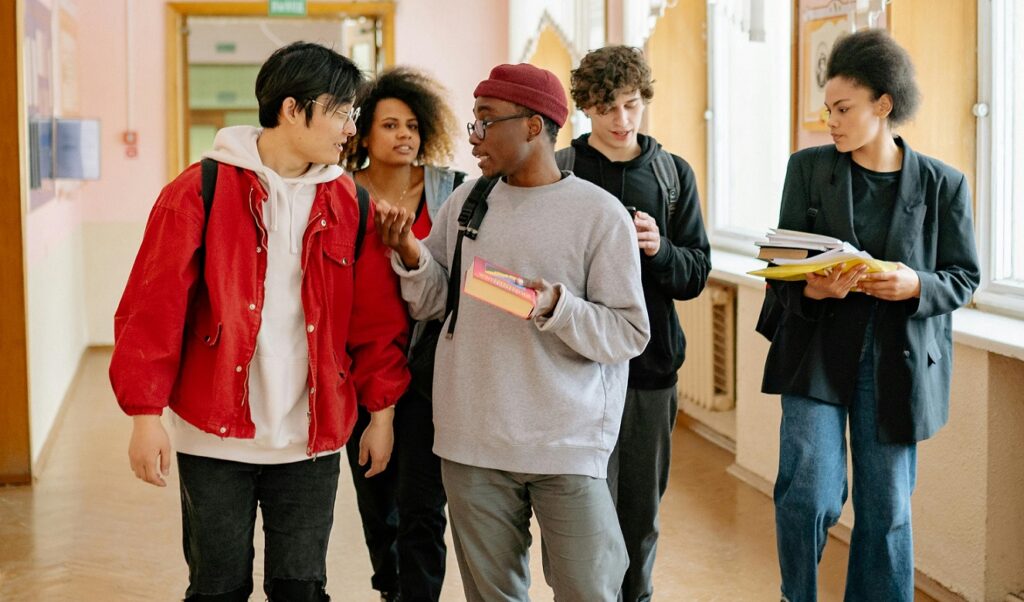6 Keys to Creating a Game Plan for Your Ensemble
Try these tactical approaches to create a positive and healthy game plan for your ensemble.
I approach teaching like a coach would their sports team. As music educators, we must always remind ourselves that music is an activity — it is an ACTIVE pastime for students.
It’s our job to make sure we inspire and equip our students with the right tools to learn and succeed. How do we do this? By having a game plan.
In this article, I will dive into some tactical approaches to creating a positive and healthy game plan, one that will make your ensemble competition ready. I will also highlight some key factors that may help you lead a successful percussion program for whatever your goals may be.
1. Student-Led Activity
What does this concept mean? I suggest that you set up a culture where your students feel in control of their destiny with direction from you. Simply put, your students must believe that they have control, but in reality, you are steering them toward success. You set the pace, and your students fall in line.
Students must see that their actions have a direct correlation to their learning, and that the time they put in contributes to the outcome of their season. When your students self-assess and inspire each other, your percussion ensemble will be a well-oiled machine. I will refer to this well-oiled machine interchangeably as your “system” or “program.”
On paper, it may sound simple to have a student-led ensemble. However, getting to this point is not easy. Creating and successfully implementing your own system will take patience, understanding and a whole lot of time.
The first and most important step in creating your system is communication. For students to thrive and buy-in to this concept, they must be empowered through responsibility, accountability and a culture in which they feel they can communicate openly.
Enable your students to control the ensemble by holding them accountable. The way you start to hold them accountable is to have open and clear expectations and guidelines for how you run your program. Below are some ideas to pave the way to a student-led program:
- Set the etiquette for how you rehearse and be consistent. When you have consistency, you subconsciously train your students that “this is how we get things done.” You’ll be amazed by the results, especially when you show them their growth by working within the etiquette.
- Set small, achievable goals. Setting bite-sized goals allow for small victories. Pinpointing these wins and using these moments as steppingstones to larger goals give students confidence, which leads to buy-in to what you are teaching.
- Teach students that on time is late, 10 minutes early is on time. This lesson is important because so many things will fix themselves if you and your students show up on time. Stress this advice from Zen Buddhism: “How you do anything, is how you do everything.”
- Be 90% positive and 10% critical. Students are far more critical of themselves than you think. Harping on the negative and breaking them down does more damage than you know. Find a positive way to encourage the change you wish to see.
- Never show your frustration. Your students look to you as the example. Be a positive role model and remember that you are the adult. Your system is only as strong as its leader, and you need to think clearly about how you react in every situation.
2. Use Technology to Your Advantage
Most students are tech savvy, so instead of dissuading the use of smart phones and tablets, encourage and implement technology in your teaching. There are some great online resources available for free, which could enable a whole new level of self-learning and self-inspiration for students.
For example, there are many online resources for percussion-specific content, such as:
- Percussive Arts Society
- The Grid Book Series
- Flo Marching offers a unique behind-the-scenes look at top programs around the country
- Vic Firth Learn the Music
- Vic Firth / Zildjian Education
Another aspect of utilizing technology are the self-assessment and self-learning tools that students can use. Playback apps or accessories like the Yamaha Electronic Acoustic Drums 10 (EAD10) and Yamaha Rec’n’Share are invaluable because they offer the ability to play along to tracks and slow or speed up the tempo.
Playing along to a metronome is certainly important for all percussion students, but this method can become tiresome. A fun and interactive approach to playing at specific tempos is with Jog FM, which lets you search songs by BPM and curate playlists for specific tempos.
3. Educator as Coach
As music educators, we should really think of ourselves as coaches. Our job is to inspire student success through encouragement, and teaching accountability is a huge element to any system of success. Think about how a golf coach teaches a student about a proper swing. The coach would never begin with what the student did wrong. Instead, the coach asks things like: “What did you feel in that last shot?” or “Did you notice your head pull up on that drive?”
The instruction is driven more by students answering questions like these and exploring their own thoughts. It is less about the coach harping on how the ball was hit into the street. We all know that the ball was hit poorly, there’s no reason to make it worse by dwelling on it. A part of the accountability is setting up the expectation and letting students know what is acceptable and what is not.
Any great basketball coach will tell you that good shooters keep shooting. Even when they are in a slump, good shooters will always take the shot. In the same vein, good drummers keep drumming! As a music educator and coach, you need to create excitement with your students and ensembles. Inspire them by introducing them to new concepts and allowing them to play with better players. Your students will never want to put their sticks down! This will create leaders within the ensemble, and your student leaders will hold their fellow “teammates” accountable.
Whether you are the sole instructor for a single school or in charge of an entire district, these elements still hold true. Strive to inspire the students to want to learn, and they will take their own playing to the next level.
 4. Create Consistency
4. Create Consistency
I went to high school with two men who were drafted into the NFL. I asked them, “What sets professionals apart from beginners?” Their answer might surprise you, but it boiled down to having a consistent schedule. Some of the best athletes I know — marathon runners, weightlifters, football players, world champion percussionists — have a consistent schedule and live by it. Consistency provides athletes and students something they can depend on. Without sticking to a schedule, my friends probably would not have made it to the NFL.
As the leader of your music program, you can create this consistency and set up your students for success. Have the band’s day-to-day schedule of rehearsals planned out at least a month in advance. Here is an over-simplified example of a weekly, after-school schedule:
- Monday: music, 2-5 p.m.
- Wednesday: learn drill, 2-5 p.m.
- Friday: play and move / ensemble the last hour, 6-9 p.m.
Notice that the WHAT-you-work-on part of the schedule will change as your season progresses. This is another aspect of the schedule that you as the leader need to manage. Prioritization of rehearsal is a skill all on its own — here are some tactics you can use:
- Allow sub-sections time to play together.
- Break down music into chunks and create exercises that you play religiously.
- Create a warmup package that is exciting and consistent. You will play it all season, so you should enjoy listening to it!
- Prioritize rehearsal time with the entire ensemble. Without a cohesive ensemble, sub sectional time means nothing.
On a macro level, just rehearsing on the same days of the week puts consistency in your students’ schedules and lives. This, of course, is dependent on scheduling gym time in collaboration with other coaches and sometimes school administrators.
Here are a few articles about schedules and teamwork that are on the Yamaha Music Educator Suite:
- Master the Master Schedule
- Build Bridges: Work with Administration, Parents and Other Teachers
- Collaboration is Key
 5. Future Proofing for Success
5. Future Proofing for Success
We’ve all been in situations where we have been asked to do something, only to be told to stop and do something totally different. It’s frustrating, right? If we ask our students to play a piece to the best of their ability, we serve them best by allowing them to play the piece in the same way, repeatedly, over a long period of time. A change throws a wrench in that process.
If students were allowed to perform the same piece of music from January to April, they would have a very good chance of perfecting the piece 10 times out of 10. What would happen if the music was changed in March and students only had two months to master it instead of four? The odds of having success in the piece go down. Now, imagine if the music was changed a week before the final show. The odds of perfecting the piece would be dramatically less.
Designers, directors and creatives are often inclined to take on a bit more than their ensemble can handle. This is OK. You want to push your students and move them outside of their comfort zones. But you must realize that this comes at a price. Not only are students taking on different musical pieces, but they will ultimately have to perform them in front of an audience. The pressures of playing to a live audience must be considered when selecting the difficulty of a piece. You must always think of the ensemble’s needs first before jumping into something that could be detrimental to the well-being of your students.
Some music educators write for and teach the group. Others just write the music. But there is a baseline that everyone should agree on — the musical intent must be clear immediately. The demand or “beef” of the music can be enhanced later.
Those who write and teach should think about other ways of creating demand. Difficulty and demand can be found in the simplest of forms.
For example, take these rhythms:


Most percussion students could play these rhythms. But for argument’s sake, can you find the technical demand? Consider the sticking of the last two groupings — are your students producing a true rhythm? Or does it sound choppy? Are they stopping the stick after the accent to play the tap notes softer? If the drums will also be marching, you need to figure out where they are geographically on the performance floor. This additional factor will create yet another level of demand to consider.
As educators, you must find the teachable moments and show that demand comes in more ways than one. Musicality presents a litany of demands that students will begin to see. Don’t forget dynamics! Adding nuance to your writing will create a maturity to your ensemble’s performance without them even knowing it.
 6. Invest in You
6. Invest in You
Time and energy can quickly become the two largest dividends music educators pay into their ensembles. This becomes especially apparent when you realize that music is often an after-school activity in many school districts. After a normal school day, teachers spend more time to further their students’ success — and this is no small thing. If you are leading one of these after-school programs, you must recognize this commitment and give yourself time to recover mentally and physically.
Check out these blog posts about self-care and healthy mental health strategies:
- The Power of a Stress-Relieving Routine
- Positive Mental Health Strategies
- Avoid Burnout
- 9 Strategies to Combat Burnout
If you feel overwhelmed, assess your schedule and reprioritize your day-to-day tasks so you can focus on your most important to-do’s. In my experience, educators tend to focus on the objectives they didn’t get to, instead of all the tasks they accomplished. Be sure to acknowledge all the great lessons that you did get to, and give yourself credit.
There are numerous resources to help you effectively schedule and prioritize your time and manage your day-to-day tasks and goals. Doing so might also help arrange goals and boost your effectiveness when you get back to teaching your students.
Here are that I have used:
- What’s All the Buzz About Mindfulness: Being mindful can create clarity and help you maintain focus on the big picture. The daily grind of teaching can take a toll, so it’s important to remove yourself from the grind from time to time and stay true to your goals.
- Dropbox / Google Drive: These simple tools can help disseminate music to your students or even act as a digital warehouse to organize your music, clean up your desktop and help you with de-cluttering.
- Passion Planner: This planner is a great way to get your thoughts and ideas on paper. The website also has a curated blog with great articles for everything from goal setting to creating better habits.
- Mile IQ: This one is a bit out of scope for this list, but it’s helpful for educators who are contract workers, which many creatives and writers tend to be. This site helps you tracking mileage to gigs and offers help with certain tax situations.
Financial investments are another element music educators and instructors must consider. Investing in proper instruments will lead to future success of any program, but funding is finite or simply non-existent in many schools.
Here are some funding articles that you might find helpful:
- Access Title IV-A Funds and Build a Stronger Music Program
- Finding Funding
- How to Get Funds from ESSA’s Title IV-A Grant Program
- Funding Resource Roundup
- Grant Writing: A 3-Step Game Plan
I hope you enjoyed this article. If you have any additional ideas about teaching percussion, please email educators@yamaha.com.
I would like to thank everyone I interviewed for this article. I gathered so much information and insight from friends, colleagues and mentors across several platforms. There are so many talented people in this world, and I consider myself lucky to know so many of you!
















